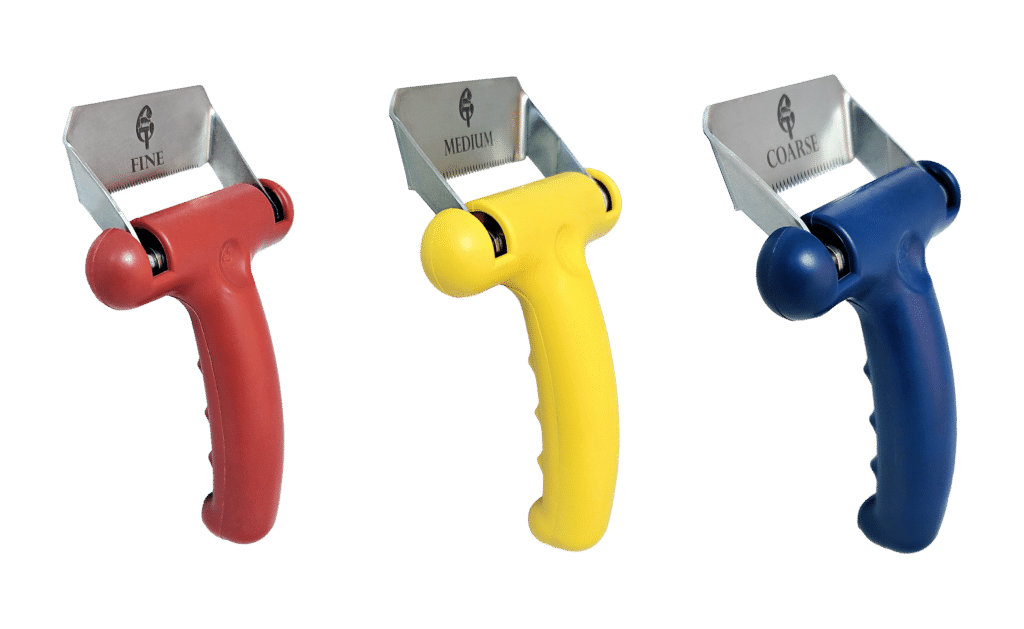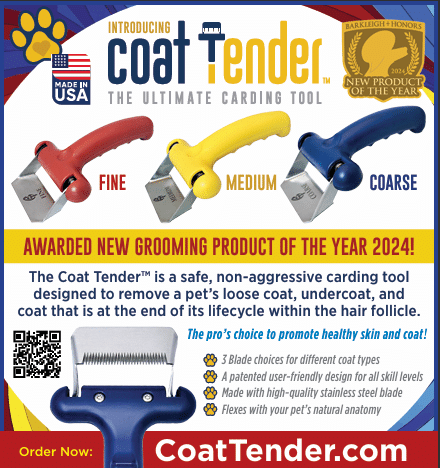By: The Jodi Murphy Grooming Staff
As groomers we tend to think that when a dog enters our salon for a haircut we immediately pull out our clipper. However, there are many breeds and mixed breeds that have a flat natural back coat that needs nothing other than a little carding and thinning shear work to polish the appearance.
Breeds like the Irish Setter, Longhaired Dachshund, Cocker Spaniels, Brittany Spaniels, Sussex Spaniel, Cavalier King Charles Spaniel, Field Spaniel, Boykin Spaniel, for example, have this type of coat.
When these breeds are clipped the coat can change texture and become very thick and wooly. If this is the case, clipping may be the only option. If clipping has previously been done, removing undercoat in conjunction with clipping will help the blades glide through the coat with ease.
Surprisingly there are dogs that have been clipped in the past and yet their coat will still remain flat and natural. In this case clipping the coat is not necessary. To shorten the length of the back coat on these breeds, backcombing and tipping the ends of the coat with thinning shears can be done for a natural appearance. When using these techniques on these breeds it not only saves time by unnecessary clipping it also saves time from blending the clipped lines into the longer furnishings. Carding and thinning shear techniques will give a beautiful seamless appearance.
When puppies come into the salon for the first time, their coat type should be evaluated. If the back coat appears flat and natural…. don’t clip it! They are your clean slate to begin these techniques on.
Carding techniques are very important for dogs that have a double coat like many Sporting and Terrier breeds. Undercoat is defined as the short, soft, dense hair that supports the outer coat or guard hair. The term “carding” describes the technique of removing undercoat from the follicles with the use of a stripping knife. Keeping undercoat at bay by using carding techniques is beneficial to the skin and the appearance of the coat.
This technique will promote healthy skin and coat by clearing the follicles of excessive undercoat. Undercoat is soft and dull in color and can prevent the skin from breathing if it becomes excessive. Once the excess undercoat is removed, the coat will shine and the skin will be able to breathe and will be healthier.
When using a stripping knife it is important to hold the skin taut with one hand while combing through the coat with the other. If the skin is not held taut it will move with every stroke, which can be uncomfortable for the pet. When the skin moves the tool will not be productive. The stripping knife should be held at an approximate 30 degree angle.
When dogs are not carded, blades will often leave track marks in the coat. It is common to want to shave them with very short blades to ensure a smoother finish. However, the undercoat is what causes the blade to leave track marks, almost like the look of corduroy. Carding techniques will eliminate the corduroy issue so a longer blade can then be used which will result in a more natural appearance.
Carding techniques take very little time and will be beneficial in the end for the groomer and the pet. Maintaining a flat natural back coat with the use of carding and thinning shear techniques not only saves time, but will give a beautiful, shiny and natural appearance to these breeds.
Introducing the Coat Tender®, the ultimate carding tool designed and patented by world-renowned groomer/educator, Jodi Murphy.

The Coat Tender® features a patented, user-friendly design suitable for all skill levels. Its ambidextrous inline handle and preset blade angle make it easy to achieve proper technique, even for beginners. The unique flexible design helps eliminate wrist strain and reduces fatigue commonly experienced with traditional carding knives.
The Coat Tender® is manufactured, and packaged in the USA, made of high-quality stainless steel to ensure durability!
We are thrilled to announce that the Coat Tender® has been honored with the prestigious Barkleigh Honors “New Product of the Year” for 2024! This award recognizes innovation and excellence within the pet grooming industry, and we couldn’t be prouder to receive this recognition. This tool was designed by Jodi to make grooming easier, more efficient, and comfortable for pets and this accolade reflects our commitment to delivering top-quality solutions for pet care professionals. Designed by a groomer for groomers!
https://www.animalbehaviorcollege.com/blog/paw-prints/to-clip-or-not-to-clip-that-is-the-question/

